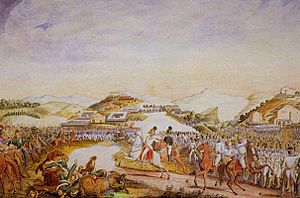Battle of Tolentino facts for kids
Quick facts for kids Battle of Tolentino |
|||||||
|---|---|---|---|---|---|---|---|
| Part of the Neapolitan War | |||||||
 The Battle of Tolentino by Vincenzo Milizia |
|||||||
|
|||||||
| Belligerents | |||||||
| Commanders and leaders | |||||||
| Strength | |||||||
| 11,938 men 1,452 horses 28 guns |
25,588 men 4,790 horses 58 guns |
||||||
| Casualties and losses | |||||||
|
800 total: 100 wounded |
4,120 total: 600 wounded 2,400 captured |
||||||
The Battle of Tolentino was a very important fight that happened on May 2–3, 1815. It took place near Tolentino, in what is now Italy. This battle was the main event of the Neapolitan War.
The war was fought by Joachim Murat, who was the King of Naples at the time. He was a general who became king under Napoleon. Murat wanted to keep his throne after Napoleon was defeated and the Congress of Vienna (a big meeting of European leaders) decided to change things.
The battle happened during a period called the Hundred Days. This was when Napoleon escaped from exile and tried to regain power. Like the famous Battle of Waterloo, the Battle of Tolentino was a big win for the countries allied against Napoleon. This alliance was called the Seventh Coalition. The battle led to the old king, Ferdinand I, returning to power in Naples.
Why the Battle Happened
By late April 1815, King Murat had lost many of the areas he had taken earlier in the war. Two groups of soldiers from the Austrian Empire were pushing his army south-east. These Austrian groups were led by Generals Bianchi and Neipperg.
The Austrian armies were separated by the Apennine Mountains. Murat hoped to defeat Bianchi's group first, which was to the west. Then, he planned to quickly turn and fight Neipperg's group, which was chasing him from the north.
Murat decided to face General Bianchi near the town of Tolentino. He sent a small group of soldiers, led by General Michele Carrascosa, to slow down Neipperg. Murat then moved his main army to meet Bianchi.
On April 29, a small group of Austrian cavalry soldiers, called hussars, easily defeated the small Neapolitan army in Tolentino. Since the Austrians were already in Tolentino, Murat's army set up camp to the north-east in Macerata. General Bianchi understood Murat's plan. He decided to hold Murat back for as long as he could. The Austrians set up a strong defense line around the Tower of San Catervo. They also placed more troops at Rancia Castle, the Maestà church, and at Saint Joseph. Murat had to attack them. The two armies finally met on May 2.
The Battle Begins
The fighting started at dawn with cannons firing from both sides. They were shooting across the valley that led north to Sforzacosta. Even though the Austrians were already set up around Tolentino, Murat's army managed to surprise them.
In the first part of the battle, Neapolitan soldiers managed to surround and capture General Bianchi near Sforzacosta. But a group of Hungarian hussars quickly freed him. By mid-morning, most of the Neapolitan army had gathered near Pollenza. There was very fierce fighting in that area.
During the first day, the main action happened around the Austrian outpost at Rancia Castle. This castle was captured and recaptured many times by both sides. By the end of the first day, the Neapolitan army seemed to be winning. They had gained a little ground, including Monte Milone. However, the Austrians were still in a very strong defensive position.
Second Day of Fighting
On the second day, thick fog delayed the start of the battle until 7:00 in the morning. The day began well for King Murat. His Neapolitan army managed to take Rancia Castle. They also captured the hills of Cantagallo. From these new positions, the Neapolitans launched another attack on the Austrian lines.
Two groups of Neapolitan foot soldiers, including Murat's special Guard Division, marched down from Monte Milone. They were attacking the left side of the Austrian army. The Neapolitans made a mistake. They formed their soldiers into a square shape, expecting a quick attack from enemy cavalry. But the cavalry attack never came. Instead, the Austrian foot soldiers fired many shots. They were also supported by powerful cannon fire.
At the same time, General Mohr had stopped an attack on the Austrian right side. Because of this, the entire Neapolitan line had to fall back to Pollenza. The battle was still not decided. Then, Murat received bad news. He heard that General Neipperg had defeated General Carrascosa's small force at the Battle of Scapezzano. This meant Neipperg's army was now getting close.
To make things even worse, Murat heard false rumors. He was told that a British fleet (a group of warships) had just landed an army from Sicily in southern Italy. This would threaten his escape route. Murat did not know that the British fleet was actually sailing to block the ports of Naples and Ancona. Murat then ordered his army to retreat, and the fighting ended.
What Happened After
The Battle of Tolentino was a clear victory for the Austrians. The Neapolitans lost over 4,000 soldiers. The Austrians lost about 800. After this big loss, the Neapolitans were defeated again by Hungarian cavalry at Castel di Sangro. The remaining parts of the Neapolitan army were finally destroyed at San Germano. Meanwhile, the entire Neapolitan navy gave up to the Royal Navy (British navy). They did this to stop the British from bombing the capital city of Naples.
King Murat went back to Naples. But with the Austrians coming by land and the British by sea, he had no choice but to escape. He fled to Corsica, dressed up as a Danish sailor. The battle was truly decisive. On May 20, 1815, Austria and Naples signed the Treaty of Casalanza. This agreement put Ferdinand IV back on the throne as king.

